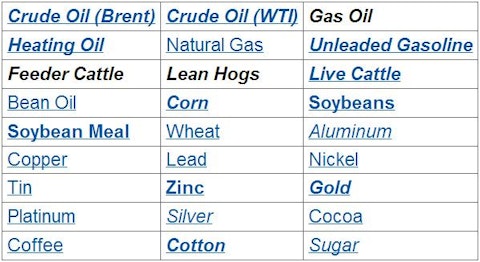
One of the more innovative “third generation” commodity ETFs to debut in recent years is the United States Commodity Index Fund (NYSEARCA:USCI). This one-of-a-kind product is the result of a collaboration between United States Commodity Funds, the firm behind the ultra-popular United States Natural Gas Fund, LP (NYSEARCA:UNG) and United States Oil Fund LP (NYSEARCA:USO), and Summerhaven.
Vital Stats
Here’s a quick look at the basic facts of USCI:
- Issuer: United States Commodity Funds
- Index: SummerHaven Dynamic Commodity Index Total Return
- Number of Commodities: 14 (from universe of 27 potential components)
- Inception Date: August 2010
- Expense Ratio: 0.95%
- Assets: $472 million (as of 10/12/2012)
- Structure: Partnership
Under The Hood
The commodities eligible for inclusion in the underlying index are presented in the following table (commodities included in the index as of June 2012 are emphasized):

Noteworthy Features
United States Commodity Index Fund (NYSEARCA:USCI) separates itself from “first generation” commodity ETPs by employing a dynamic roll methodology which looks to mitigate the negative impacts of contango. As such, this fund is unique in that the underlying portfolio can change from month to month; out of 27 possible components, 14 are selected every month to make up the underlying index. The process for determining which commodity futures to include is entirely rules-based. The strategy methodology by United States Commodity Index Fund (NYSEARCA:USCI) is based on a significant amount of academic research into factors that can be predictive of above average returns from commodity futures [see also Six Academic Studies Every Commodity Investor Must Read].
Specifically, the underlying index is constructed in a two-step process:
1. The seven commodities with the highest percentage price difference between closest-to-expiration futures and next closest-to-expiration futures are included. In other words, those with the steepest degree of backwardation or most moderate contango are selected first.
2. Of the remaining 20 eligible commodities, those with the best price performance over the last year are selected for inclusion.
In constructing the basket of holdings, each commodity family (e.g., precious metals, agriculture) must be represented each month; this approach results in a well-balanced basket of futures that is hard to find in other broad-based commodity ETPs. USCI’s methodology has the effect of potentially minimizing the adverse impact of contango on performance. Moreover, if backwardation in futures markets is an indication of tight inventories, this strategy can be effective for generating alpha within the commodities asset class [see also 25 Things Every Financial Advisor Should Know About Commodities].
For investors looking to gain broad exposure to commodities, United States Commodity Index Fund (NYSEARCA:USCI) is a compelling product that makes use of a unique approach to natural resource futures to bring potential return enhancement benefits to portfolios. Investors should note that the underlying assets are futures contracts; USCI, like other broad commodity ETPs, will not offer exposure to spot natural resource prices. In certain environments, the gap relative to a hypothetical “spot return” may be significant.
A couple other aspects of USCI are noteworthy. This product is organized as a partnership, and will be treated as such for tax purposes. That means that investors can generally expect to experience a tax event annually regardless of whether or not they sold shares, and can also expect to get a K-1 in the mail that will have to be completed.
It’s also important to note that as a “third generation” ETP, USCI is a bit more expensive than some of the other commodity funds out there. With a management fee of 0.95%, USCI is nearly twice as expensive as low-cost products like UBS AG Linked to the Dow Jones-UBS Commodity Index Total Return (NYSEARCA:DJCI).
How To Use
USCI can be used in a number of different ways, depending on investment objectives and risk restraints. This product certainly can have appeal to those building a long-term, buy-and-hold portfolio, though it generally makes sense to limit exposure to about 5% or 10% of total assets. USCI can also be a handy tool for more tactical exposure over a shorter period of time for investors looking to bet on a short-term pop in natural resource prices.
This article was originally written by Stoyan Bojinov, and posted on CommodityHQ.
